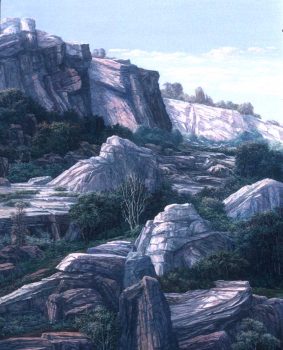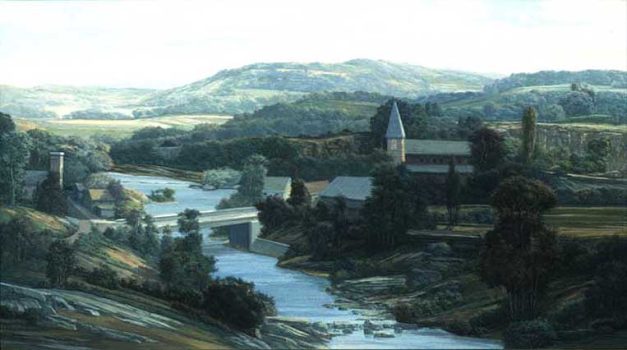

George Wexler (January 18, 1923 – ) American landscape artist heavily influenced by the Hudson River School and the countryside in which he lives and works. For George Wexler, landscape is an immense area bathed in light and shadow. He can depict a brightly glowing stand of trees right next to one locked in shadow. A deft master of perspective, he repeatedly documents long views in which farms, factories, roads, bridges, and other signs of man’s presence accent or define the landscape. In direct contrast to Frederic Church’s painterly exuberance, Wexler approaches his subject matter with a meticulousness that is both respectful and contemplative.
Wexler spent his first 18 years in Brooklyn, served in the Army in Europe during World War II, and returned to New York for four years of study at the Cooper Union School of Art. Then he went to Michigan State University to earn an MA and from 1950 to 1957 was assistant professor of design there. In 1957 he was appointed a professor of painting at the State University of New York at New Paltz.
As a teenager, Wexler studied at the Brooklyn Museum and did a form of New York social realism – beggars and street scenes – although he says that at that age he had no real understanding of his subjects. During his years in Michigan, and also when he first came to New Paltz – a total of eight years – he worked abstractly. He was quite successful in showing and selling his work; Walter P. Chrysler, Jr., was one of his early collectors.
Despite his successes, Wexler became increasingly uneasy and dissatisfied with what he was doing. He attributes part of the change to the influence of his new environment, the countryside around New Paltz. Gradually, around 1960, he began working from nature, evolving an expressionistic style of landscape which grew more structured, more detailed, and truer to natural color as the years passed. When he began working from nature, his original collectors lost interest; he and his wife, Thyra Davidson, who also works in a realist style, began to feel isolated from the art world around them. Eventually, though, they did search out and find support from association with other realist artists in New York, people like Gabriel Laderman, Lennart Anderson, Philip Pearlstein, and Theophil Groell. George Wexler’s philosophy of art has undergone a corresponding change. He has become increasingly militant about promoting a realist vision. His is not simply a partisan response but a carefully thought-out point of view. A strong influence on his thinking has been John Gardner’s “On Moral Fiction”. Of particular interest is Gardner’s criticism of the emphasis on surface texture, rather than structure and meaning, in the contemporary arts. Typically, Wexler’s paintings are panoramic in scope, while conveying a wide range of detail. The paintings tend to be small in scale, their surfaces smooth as polished teak.
Museums showing Wexler’s work include, Albany Institute of Art, Albany, NY, Chrysler Museum of Art, Norfolk, VA, Haggerty Museum, Milwaukee, WI, Samuel Dorsky Museum of Art, New Paltz, NY, Schenectady Museum of Art, Schenectady, NY.

